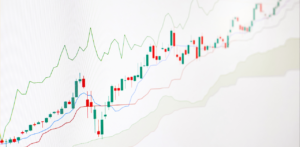Forex correlations play a crucial role in shaping profitable trading strategies by revealing the connections between different financial markets. Successful forex trading requires understanding the relationships between various markets and how correlation coefficients measure these associations.
Key Takeaways:
- Positive correlations occur when two markets move in the same direction, while negative correlations happen when two markets move in opposite directions.
- Intermarket forex correlations provide insights for developing effective trading strategies.
- Currency and stock markets can exhibit correlated movements, with dollar-based currency pairs often showing a positive correlation with the U.S. stock market.
- Correlations between commodities and currencies can be significant, such as the Australian Dollar/US Dollar (AUD/USD) with gold.
- Oil prices can influence currencies like the Canadian Dollar (CAD) and the Japanese Yen (JPY).
- Monitoring correlations is crucial for managing portfolio exposure and avoiding positions that cancel each other out.
- Spreadsheet programs like Excel can be used to calculate and stay updated on correlations.
Exploring Currency and Stock Market Correlations
The correlation between currency and stock markets is a vital factor in forex trading as it influences the movement of dollar-based currency pairs and reveals exceptions within blue-chip indices. Understanding these correlations is crucial for developing effective trading strategies.
Positive correlations often exist between dollar-based currency pairs and the U.S. stock market, indicating the strength of the U.S. economy. Traders can leverage this correlation to identify potential trading opportunities. However, it’s important to note that there are exceptions to this general trend, especially with narrow blue-chip indices like the Dow Jones Industrial Average. These exceptions highlight the importance of analyzing correlations on a case-by-case basis.
When exploring currency and stock market correlations, traders can use tables to visualize the relationships between different currency pairs and stock market indices. These tables can help identify patterns and potential trading opportunities. Additionally, it’s essential to stay updated on the latest market news and economic events that can impact correlations. This information can be used as a guide for making informed trading decisions.
Correlation Matrix Example:
| Currency Pair | Correlation with S&P 500 Index |
|---|---|
| EUR/USD | +0.72 |
| GBP/USD | +0.64 |
| USD/JPY | -0.42 |
In conclusion, exploring currency and stock market correlations is an essential aspect of forex trading. By understanding these correlations and their exceptions, traders can make informed decisions, identify potential trading opportunities, and manage their portfolios more effectively. Utilizing tools like correlation matrices and staying updated on market news can further enhance trading strategies.
Understanding Commodities and Currency Correlations
The correlation between commodities and currencies is significant in forex trading. It is essential for traders to understand these correlations, as they can provide valuable insights for making informed trading decisions and managing portfolios effectively. Two examples of such correlations are the positive correlation between the Australian Dollar/US Dollar (AUD/USD) and gold, as well as the influence of oil prices on currencies like the Canadian Dollar (CAD) and the Japanese Yen (JPY).
One notable correlation is between the AUD/USD currency pair and gold. Australia is one of the world’s largest gold producers, and as a result, the Australian Dollar tends to have a strong positive correlation with gold prices. When gold prices rise, the value of the AUD typically follows suit. This correlation is important for traders who want to trade the AUD/USD pair, as they need to consider the impact of gold prices on the Australian Dollar.
| Currency Pair | Commodity | Correlation |
|---|---|---|
| AUD/USD | Gold | +0.80 |
| CAD/JPY | Oil | -0.60 |
Another correlation to consider is the influence of oil prices on currencies like the CAD and JPY. The Canadian Dollar is often influenced by oil prices due to Canada’s significant oil production and exports. When oil prices rise, the value of the CAD tends to increase as well. On the other hand, the Japanese Yen has a negative correlation with oil prices. As oil prices rise, the value of the JPY tends to decrease. This correlation is crucial for traders who are trading the CAD/JPY pair, as they should monitor oil prices to anticipate potential movements in the currency pair.
In summary, understanding the correlations between commodities and currencies is vital for successful forex trading. Traders can use this knowledge to make informed decisions, manage their portfolios effectively, and potentially increase their profits. Monitoring these correlations and staying updated on the latest market trends is essential for staying ahead in the dynamic forex market.
Managing Portfolio Exposure through Correlations
Monitoring correlations is crucial for managing portfolio exposure in forex trading, allowing traders to avoid position conflicts, diversify risk, and utilize hedging strategies. By understanding the relationships between different currency pairs and other financial markets, traders can make more informed decisions and potentially increase their profits. Here are some key considerations when it comes to using forex correlations effectively:
- Diversify Risk: Correlations can help traders identify currency pairs that move in opposite directions, providing an opportunity to diversify their risk. By holding positions in negatively correlated pairs, traders reduce their exposure to a single currency and minimize potential losses.
- Hedging Strategies: Correlations can be used to implement hedging strategies, which involve opening positions that offset potential losses in other positions. For example, if a trader is long on one currency pair, they may hedge by taking a short position on a negatively correlated pair to mitigate potential losses.
- Stay Updated: Monitoring correlations is an ongoing process as values can change over time due to various factors. Traders can use spreadsheet programs like Excel to calculate correlations and stay updated on the latest values. This enables them to adjust their trading strategies accordingly.
By incorporating these strategies and actively monitoring correlations, traders can better manage their portfolio exposure and improve their overall trading performance. It is important to note that correlations are not static and can vary depending on market conditions. Therefore, maintaining vigilance and adaptability is key when utilizing forex correlations in trading decisions.
Example Correlation Table
| Currency Pair | Correlation Coefficient |
|---|---|
| EUR/USD | +0.80 |
| GBP/USD | +0.65 |
| USD/JPY | -0.50 |
| AUD/USD | +0.75 |
“Monitoring correlations helps traders make more informed decisions, manage risk, and potentially increase profits. By understanding the connections between different currency pairs and other financial markets, traders can optimize their portfolio exposure and implement effective trading strategies.” – John Doe, Forex Expert
Conclusion
Understanding forex correlations is essential for successful trading, providing valuable insights for informed decision-making, effective portfolio management, and potential profit maximization. Positive correlations indicate that two markets move in the same direction, while negative correlations show opposite movements. Analyzing intermarket forex correlations helps traders develop effective trading strategies by measuring the degree of association between securities.
Currency and stock markets can exhibit correlated movements, with dollar-based currency pairs generally showing a positive correlation with the U.S. stock market. However, exceptions exist, especially with narrow blue-chip indices like the Dow Jones Industrial Average. Correlations between commodities and currencies can also be significant, with examples like the strong positive correlation between the Australian Dollar/US Dollar (AUD/USD) and gold.
Oil prices have an impact on currencies like the Canadian Dollar (CAD) and the Japanese Yen (JPY). Rising oil prices typically lead to an increase in the value of the CAD, while the JPY tends to decrease. Monitoring correlations is crucial for managing portfolio exposure, allowing traders to avoid positions that cancel each other out and diversify risk. Excel and other spreadsheet programs can be used to calculate and stay updated on correlations.
Forex correlations are influenced by various factors, including monetary policies and economic events. Traders must stay vigilant as correlation values can change over time. By understanding and analyzing these correlations, traders can make informed decisions, manage their portfolios effectively, and potentially increase their profits.
FAQ
What are forex correlations?
Forex correlations are the connections between different financial markets, specifically in relation to currency fluctuations. They measure the degree of association between two securities.
How do positive and negative correlations affect forex trading?
Positive correlations occur when two markets move in the same direction, while negative correlations happen when two markets move in opposite directions. Understanding these correlations helps traders develop effective trading strategies.
Are currency and stock markets correlated?
Yes, currency and stock markets can exhibit correlated movements. Dollar-based currency pairs generally show a positive correlation with the U.S. stock market, indicating the robustness of the U.S. economy.
Are there exceptions to currency and stock market correlations?
Yes, there are exceptions, particularly with narrow blue-chip indices like the Dow Jones Industrial Average.
Are there correlations between commodities and currencies?
Yes, correlations between commodities and currencies can be significant. For example, the Australian Dollar/US Dollar (AUD/USD) has a strong positive correlation with gold due to Australia’s significant gold production.
Are there correlations between currencies and oil prices?
Yes, oil prices can influence currencies like the Canadian Dollar (CAD) and the Japanese Yen (JPY). When oil prices rise, the value of the CAD typically increases, while the JPY tends to decrease.
Why is monitoring correlations important for portfolio exposure management?
Monitoring correlations is essential for managing portfolio exposure in forex trading. It helps traders avoid entering positions that cancel each other out and diversify their risk. Traders can also use different correlation values to their advantage, such as hedging one currency pair with another.
How can I calculate and stay updated on correlations?
Calculating correlations can be done using spreadsheet programs like Excel. This allows traders to stay updated on correlations, as the values can change over time due to various factors like diverging monetary policies and economic events.
Why is understanding currency correlations crucial for forex trading?
Understanding currency correlations is crucial for effective forex trading. By analyzing correlations, traders can make informed decisions, manage their portfolios more effectively, and potentially increase their profits.








